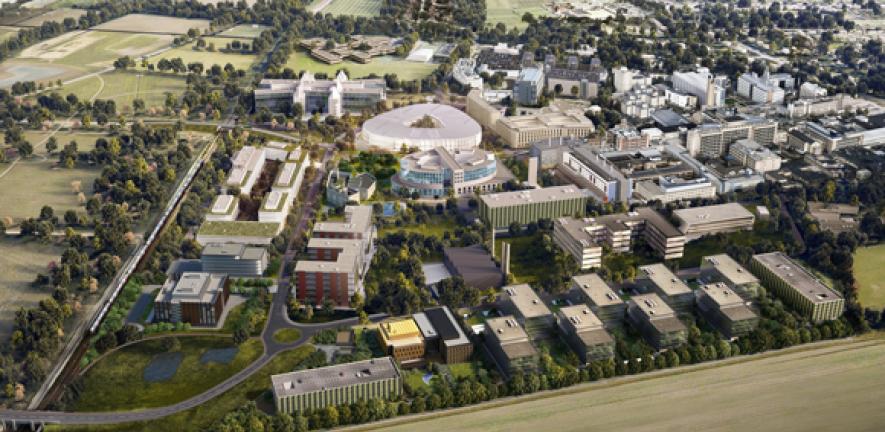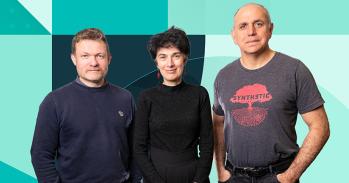
Almost 30 years on from the discovery of the genetic defect that causes cystic fibrosis, treatment options are still limited and growing antibiotic resistance presents a grave threat. Now, a team of researchers from across Cambridge, in a major new centre supported by the Cystic Fibrosis Trust, hopes to turn fortunes around.
Almost 30 years on from the discovery of the genetic defect that causes cystic fibrosis, treatment options are still limited and growing antibiotic resistance presents a grave threat. Now, a team of researchers from across Cambridge, in a major new centre supported by the Cystic Fibrosis Trust, hopes to turn fortunes around.
We have an opportunity to uplift UK cystic fibrosis research in general by providing knowhow, training and reagents in a number of areas including genomics, bioinformatics, stem cells and clinical trials technology
Andres Floto
John Winn’s office at Microsoft Research looks like that of any typical academic: on one wall is a whiteboard graffitied with impenetrable equations and mathematical scribblings, on the opposite wall books and files line shelves, and on his desk are photos of his family.
His desk, however, is somewhat different: it can rise or fall, depending on whether he wants to work standing or sitting – and underneath is a treadmill for walking and working at the same time. “There have been times when I’ve been deep in thought and almost fallen off it,” he jokes.
Winn has cystic fibrosis (CF) and keeping fit is an important part of managing his condition: the stronger his lung function, the better equipped he is to fight the potentially life-threatening infections that plague people living with the condition.
CF occurs when an individual inherits two copies of a single genetic variant, one from each parent. The disease causes a build-up of thick, sticky mucous in the lungs, intestines and organs, and those affected by the condition are particularly susceptible to lung infections leading to progressive inflammatory lung damage. Although life expectancy for people with CF has almost doubled in recent decades, it is still significantly below average.
Winn is a machine learning specialist and is using his expertise to fight the condition that affects his everyday life. Together with Professor Andres Floto from the Department of Medicine at Cambridge, he is turning data from the daily lives of people with cystic fibrosis into potentially life-saving information.
As part of this study, funded by the Cystic Fibrosis Trust and Royal Papworth Hospital, participants have been submitting data – everything from heart rate and lung function through to self-reported wellbeing – via an app that also monitors their activity levels. Machine learning then sifts through the data, looking for patterns and – it’s hoped – building a model that can predict when a patient’s health is about to deteriorate and advise them to seek medical help.
“The overarching principle is about giving people control over their own health data and making it work for them,” says Winn. “There’s some informal feedback that just participating in the study and taking these readings has already improved health outcomes for some individuals: for example, it’s helped with adherence with taking their medications as they noticed that if they missed taking certain medicines, their readings got worse.”
The project is just one strand of a major new Cystic Fibrosis Innovation Hub based on the Cambridge Biomedical Campus and run by Floto. The Hub is supported through a £5 million commitment from the Cystic Fibrosis Trust and matching funds from the University of Cambridge. It will strengthen existing collaborations across the University and with the Wellcome Trust Sanger Institute, as well as build new collaborative research networks with CF centres around the UK. The Trust’s Chief Executive, David Ramsden, said it will “provide in CF research across the country”.
Floto agrees with this sentiment: “We have an opportunity to uplift UK CF research in general by providing knowhow, training and reagents in a number of areas including genomics, bioinformatics, stem cells and clinical trials technology.”
A major part of the Hub’s activities will be around developing new drugs that target chronic inflammation in CF, in collaboration with the pharmaceutical company GSK as part of the GSK/Cambridge Strategic Partnership, as well as new antibiotic therapy for the main causes of lung infection in the condition.
Finding new drugs against these bacteria is becoming increasingly urgent – Floto and Professor Julian Parkhill at Sanger recently showed that Mycobacterium abscessus, the pathogen behind one of the most serious infections, is becoming increasingly multi-drug resistant and spreading globally. This is one reason why people with CF are advised not to meet each other.
“Clearly the techniques that we develop – and the drug-like molecules that come out of it – will have more general applicability to patients with other multi-drug resistant infections,” Floto says. This will be welcome news to England’s Chief Medical Officer, Professor Dame Sally Davies, who has warned of a future where “any one of us could go into hospital in 20 years for minor surgery and die because of an ordinary infection that can’t be treated by antibiotics.”
The timing of all this is particularly good: Papworth Hospital, whose Adult Cystic Fibrosis Centre has gained a national and international reputation for its treatment of patients and its contribution to research, is due to move to the Biomedical Campus later in 2018. The CF wards will feature state-of-the-art air flow systems, designed with Floto’s work on the spread of multi-drug resistant CF pathogens in mind.
This close proximity between the patients and the researchers will help Floto test the new treatments he is pioneering. He is particularly excited about the potential for new cellular therapies he’s developing with Professor Ludovic Vallier at the Department of Surgery. Floto describes these as their “moon shot”. These would involve taking cells from a CF patient, re-programming them – correcting the genetic defect along the way – and then re-injecting them into patients. “This could provide a way to regenerate damaged lungs,” he says.
Floto knows his plans for the Hub are ambitious, but given that it’s almost 30 years since the gene that causes CF was discovered and there is still no cure for the disease, believes it’s time to take this shot at the moon.
Floto’s collaborators in the CF Innovation Hub include Chris Abell (Chemistry), Sir Tom Blundell (Biochemistry), Julian Parkhill and Ludovic Vallier.
A no-strings-attached scientific relationship
Professor Claire Bryant, like Floto, works on an inflammatory lung disease as part of the GSK/Cambridge Strategic Partnership. In her case, she’s looking at chronic obstructive pulmonary disease (COPD).
COPD is a condition caused by smoking, pollution and severe asthma. Bryant is looking in particular at how COPD makes the lungs ‘stickier’ to bacteria, increasing the risk of infections.
She holds two grants under the GSK/Cambridge Strategic Partnership, which aims to develop the next wave of ‘game-changing’ medicines by bringing academic and industrial expertise together to tackle often intractable disease. Based at Cambridge’s Department of Veterinary Medicine, Bryant currently has a three-day-a-week sabbatical at GSK’s headquarters in Stevenage. As such, it’s arguable whether anyone embodies the partnership more than she does.
The three-year sabbatical provides Bryant with three postdocs, two PhD students and budget, with access to GSK resources, but with “no strings attached”. The only proviso is that if she works with a GSK reagent, they have first rights on what she does with this. Crucially, she says, it gives her “the space to think”.
Bryant is embedded in GSK’s Respiratory Drug Discovery Unit and attends its lab meeting every week. “I’ve met really smart, clever scientists at GSK, with different skills to those of us in academia,” she says. “I get to see all aspects of what happens at GSK, everything from how a target is identified to how drugs are developed to target it, through to taking these drugs to clinical trials. I see the whole spectrum.”
It is, though, a mutually beneficial programme, she stresses. Bryant brings her knowledge of innate immunity and her experience of multi-disciplinary collaborations, particularly in imaging. “It’s effectively like being a consultant,” she says. “I want them to get as much out of me as I do out of them.”

The text in this work is licensed under a Creative Commons Attribution 4.0 International License. For image use please see separate credits above.




